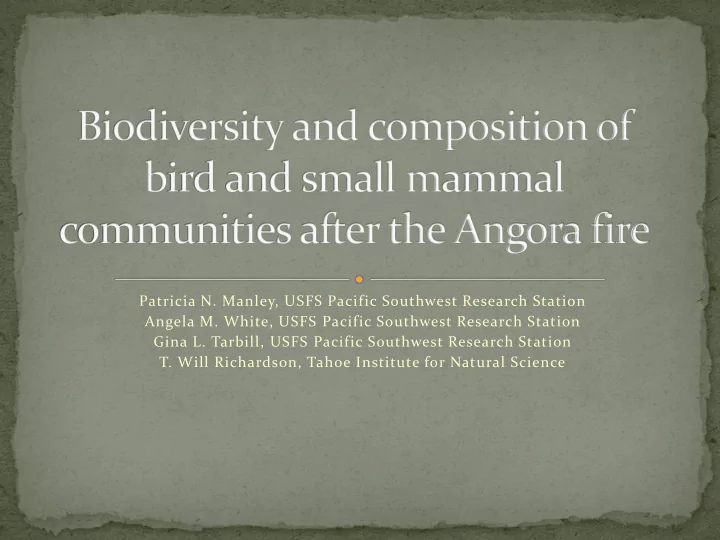

Patricia N. Manley, USFS Pacific Southwest Research Station Angela M. White, USFS Pacific Southwest Research Station Gina L. Tarbill, USFS Pacific Southwest Research Station T. Will Richardson, Tahoe Institute for Natural Science
Burned 1,255 hectares Burn severity varied due to wind, slope, fuel load, and fire- fighting efforts On Wildland-Urban Interface Post-fire harvest largely limited to WUI
• Modifies forest structure and composition • Alters arthropod populations • Creates snags and woody debris Photo credit: USDA Forest Service • Creates, alters, and destroys wildlife habitat
How do bird and small mammal communities differ by burn severity? How does time since fire, urbanization, and post- fire harvest affect this response?
How do species richness and abundance of 36 avian and 11 mammalian species differ?
1.4 1.2 Lazuli Bunting Mean abundance Olive-sided Flycatcher 1 Western Bluebird 0.8 Mountain Bluebird 0.6 Black-backed Woodpecker 0.4 House Wren Hairy Woodpecker 0.2 0 None Low Moderate High Burn severity 10 9 8 Mean abundance 7 6 5 Long-eared Chipmunk 4 Deer Mouse 3 2 1 0 None Low Moderate High Burn severity
Six species of birds and eight species of small mammals increased in abundance after first year Several species had highest abundance in second year No significant difference between burned and unburned by year three 4.5 Douglas Squirrel 4 3.5 Golden-mantled Ground 3 Squirrel 2.5 2 1.5 1 0.5 0 none low moderate high none low moderate high none low moderate high Year 1 Year 2 Year 3
Harvest was limited No species had lower abundance in treated sites Five bird and one small mammal species had higher abundance in treated sites None were fire-specialists
Several fire- adapted species had slower “recovery” in urban sites Four species “recovered” more quickly in urban areas 0.7 0.6 Change from first to third year Urban 0.5 Wild 0.4 0.3 0.2 0.1 0 -0.1 -0.2 -0.3 Hairy House Wren Mountain Pine Siskin White-crowned Yellow-rumped Evening Black-headed Woodpecker Bluebird Sparrow Warbler Grosbeak Grosbeak
Majority of birds and small mammals responded positively or neutrally to increasing burn severity Fire specialists did not exhibit a decreasing year effect Most species increased over time Species that rely on live trees for foraging or nesting sites likely to decline with increasing burn severity
Birds 20 30 17 25 18 Mean total abundance Mean species richness Mean total abundance 16.5 Mean species richness 25 16 20 16 14 20 15.5 12 15 10 15 15 8 10 14.5 10 6 14 4 5 5 13.5 2 0 0 13 0 None Low Moderate High Year 1 Year 2 Year 3 Burn severity Time since fire Total abundance Species richness Total abundance Species richness Small mammals 9 Mean species richness 30 10 8 7 25 6 8 Total abundance 5 Species richness 20 4 6 3 15 2 4 1 10 0 none low moderate high none low moderate high none low moderate high Burn 2 5 severity 0 0 none low moderate high Year 1 Year 2 Year 3 Total abundance Species richness
Species richness of birds was highest in sites that burned at high severity Species richness of small mammals was highest in low burned sites Richness of small mammals equal in year three for high and unburned
Harvest in urban areas may have less of an impact on fire- dependent species Burned urban and wildland sites do not support similar communities Severely burned sites provide habitat for many species Burned areas support a wide variety of birds and small mammals especially at larger time and spatial scales
Southern Nevada Public Lands Management Act California Tahoe Conservancy Tahoe Institute for Natural Science Lake Tahoe Basin Management Unit, USFS Region 5 Ecology Group, USFS University of Montana Photo credits: Naturepicsonline
Recommend
More recommend